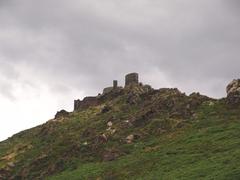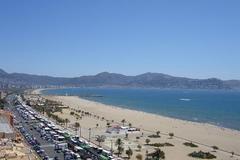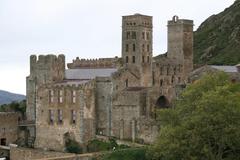Comprehensive Guide to Visiting Camí de Ronda, Roses, Spain
Date: 01/08/2024
Introduction
Embark on an unforgettable journey along the historic Camí de Ronda in Roses, Spain. This coastal pathway, with origins dating back to the 19th century, was initially constructed to connect coastal villages and provide a safe route for fishermen and sailors (Camí de Ronda Historic Note). Over the years, its purpose evolved, especially during the 19th century when it became a crucial tool in combating smuggling and illegal trade along the coast, patrolled by the Royal Corps of Coast Policemen and later the Guardia Civil (Wikipedia).
Today, the Camí de Ronda has transformed into a beloved tourist trail that offers stunning views of the Mediterranean Sea, picturesque coves, and charming coastal villages. It has become an essential attraction for hikers, nature lovers, and history enthusiasts alike, providing a unique blend of scenic beauty and cultural heritage (Njoy Costa Brava). This comprehensive guide will delve into the historical significance, visitor information, travel tips, and much more, ensuring you have all the necessary knowledge to make the most of your visit to this remarkable trail.
Table of Contents
- [Historical Background](#historical-backgroundhistorical-background)
- [Origins and Early Use](#origins-and-early-useorigins-and-early-use)
- [Role in Anti-Smuggling Efforts](#role-in-anti-smuggling-effortsrole-in-anti-smuggling-efforts)
- [Post-War Period and Economic Impact](#post-war-period-and-economic-impactpost-war-period-and-economic-impact)
- [Transition to a Tourist Attraction](#transition-to-a-tourist-attractiontransition-to-a-tourist-attraction)
- [Modern-Day Significance](#modern-day-significancemodern-day-significance)
- [Notable Historical Sites Along the Route](#notable-historical-sites-along-the-routenotable-historical-sites-along-the-route)
- [Cultural and Environmental Initiatives](#cultural-and-environmental-initiativescultural-and-environmental-initiatives)
- [Visitor Information](#visitor-informationvisitor-information)
- [Visiting Hours and Tickets](#visiting-hours-and-ticketsvisiting-hours-and-tickets)
- [Travel Tips](#travel-tipstravel-tips)
- [Best Time to Visit](#best-time-to-visitbest-time-to-visit)
- [Accommodation](#accommodationaccommodation)
- [Trail Navigation](#trail-navigationtrail-navigation)
- [What to Pack](#what-to-packwhat-to-pack)
- [Safety Tips](#safety-tipssafety-tips)
- [Dining and Local Cuisine](#dining-and-local-cuisinedining-and-local-cuisine)
- [Transportation](#transportationtransportation)
- [Nearby Attractions](#nearby-attractionsnearby-attractions)
- [Family-Friendly Options](#family-friendly-optionsfamily-friendly-options)
- [Guided Tours](#guided-toursguided-tours)
- [Additional Resources](#additional-resourcesadditional-resources)
- [FAQ](#faqfaq)
- [Recommended Day Hikes](#recommended-day-hikesrecommended-day-hikes)
- [Call to Action](#call-to-actioncall-to-action)
Historical Background
Origins and Early Use
The Camí de Ronda, also known as the Camino de Ronda in Spanish, is a historic footpath that traces the rugged coastline of Costa Brava, connecting various villages, beaches, and coves. The origins of this path can be traced back to the 19th century, although it is believed that the route has been used for much longer, possibly since ancient times. The primary purpose of the Camí de Ronda was to facilitate communication between coastal settlements and to provide a safe return route for fishermen and sailors who might wreck against the seaside rocks (Camí de Ronda Historic Note).
Role in Anti-Smuggling Efforts
In the 19th century, the Camí de Ronda gained significant importance as a tool for combating smuggling and illegal trade along the coast. The Royal Corps of Coast Policemen and Spanish Frontiers, established in 1829, was tasked with monitoring the coastline to prevent fraud and smuggling. These coast policemen, known as Carabineros, patrolled the path to control the illegal activities that were rampant along the coast (Camí de Ronda Historic Note).
During the Spanish Civil War (1936-1939), the responsibilities of the Carabineros were transferred to the Guardia Civil, the Spanish military guards. The Guardia Civil continued to use the Camí de Ronda to patrol the coastline and curb smuggling activities. Despite these efforts, corruption and the challenging economic conditions in post-war Spain allowed smuggling to persist, with smugglers amassing significant fortunes by trading in scarce goods (Wikipedia).
Post-War Period and Economic Impact
The post-war period saw the Camí de Ronda becoming even more crucial for border control and anti-smuggling operations. The economic hardships of the 1940s and 1950s, characterized by shortages of basic foods, tools, and other products, made smuggling a lucrative business. The Guardia Civil’s patrols along the Camí de Ronda were aimed at curbing these illegal activities, but the persistence of smuggling highlighted the limitations of these efforts (Wikipedia).
Transition to a Tourist Attraction
With the improvement of the Spanish economy and the country’s eventual entry into the European Union, the significance of the Camí de Ronda as a tool for border control and anti-smuggling operations diminished. The path gradually transformed into a series of public footpaths that connect tourist beaches and resorts along the Costa Brava. Today, much of the route is part of the GR 92 long-distance footpath, which runs the length of the Mediterranean coast of Spain (Wikipedia).
Modern-Day Significance
In recent years, the Camí de Ronda has become a popular destination for tourists and hikers. The path offers stunning views of the Mediterranean Sea, picturesque coves, and charming coastal villages. The trail is well-maintained and accessible to people of all fitness levels, with some sections even adapted for wheelchair users. The beauty of the Camí de Ronda lies in its versatility, allowing visitors to explore different segments of the trail at their own pace (Njoy Costa Brava).
Notable Historical Sites Along the Route
The Camí de Ronda passes through several historically significant sites, adding to its allure for history enthusiasts. One such site is the Ciutadella de Roses, an impressive fortress that houses the ruins of ancient Greek, Roman, and Visigoth settlements. The Ciutadella de Roses also features a museum that provides insights into the region’s rich history (Njoy Costa Brava).
Another notable site along the Camí de Ronda is the Poblat Ibèric de Castell, the ruins of an indigenous Iberian settlement dating back to between the 6th century B.C.E. and the 1st century A.D. This site is located near the beautiful Platja de Castell beach, which remains in its natural state thanks to local efforts to prevent development (Njoy Costa Brava).
Cultural and Environmental Initiatives
In April 2024, a new project was announced to link the Camí de Ronda with the trails in French Catalunya, creating a continuous path from Argelès-sur-Mer to Malgret-de-Mar. This initiative, known as the “Camí de Mar,” aims to upgrade and improve the trails along this 250km stretch. The project emphasizes environmental protection, respect for the coast, and the promotion of year-round tourism with more overnight stays in different towns along the route (Njoy Costa Brava).
Visitor Information
Visiting Hours and Tickets
Most sections of the Camí de Ronda are open year-round and free to access. However, certain historical sites along the route, such as the Ciutadella de Roses, may have specific visiting hours and entrance fees. It is advisable to check the official websites for the most up-to-date information on opening hours and ticket prices.
Travel Tips
- Best Time to Visit: The best time to explore the Camí de Ronda is during the spring and fall when the weather is mild and the trail is less crowded.
- What to Bring: Comfortable walking shoes, water, sunscreen, and a hat are essential. A camera is also recommended to capture the stunning views.
- Guided Tours: For a more informative experience, consider joining a guided tour. Several local companies offer guided hikes that include historical insights and visits to notable sites.
- Nearby Attractions: Don’t miss the beautiful coastal towns of Tossa de Mar and Llafranc, both offering charming streets, beaches, and excellent dining options.
- Accessibility: While many sections of the trail are accessible to people of all fitness levels, some parts are rugged and may not be suitable for those with mobility issues. There are, however, sections adapted for wheelchair users and families with strollers.
Best Time to Visit
The Camí de Ronda can be enjoyed year-round, but the ideal times are during the spring (April-May) and autumn (September-October) seasons. These periods offer cooler temperatures perfect for hiking and fewer crowds compared to the peak summer months (Spain.info). Summer (July-August) is also a popular time due to the warm Mediterranean waters, but be prepared for higher temperatures and more tourists (Ottsworld).
Accommodation
Roses offers a variety of accommodation options ranging from budget-friendly hotels to luxurious resorts. A popular choice is the Prestige Mar y Sol, located right on the beach promenade, known for its excellent breakfast (123GoTravelBlog). For those looking for a unique experience, consider staying at Hotel Cala Joncols, situated halfway between Cadaqués and Roses, though it’s advisable to check weather conditions as it can be quite remote (123GoTravelBlog).
Trail Navigation
The Camí de Ronda is well-marked, but it’s always a good idea to have a digital trail map. The All Trails application is highly recommended as it provides a complete trail map and individual sections (123GoTravelBlog). Additionally, free digital trail maps can be downloaded from Costa Brava Wandern, which can be imported into various hiking apps.
What to Pack
Given the varying terrain and weather conditions, it’s essential to pack appropriately. Here are some must-haves:
- Hiking Poles: Useful for navigating steep sections and uneven terrain (123GoTravelBlog).
- Comfortable Footwear: Sturdy hiking boots are recommended.
- Weather-Appropriate Clothing: Layers are ideal for adjusting to changing temperatures. A waterproof jacket is advisable in case of rain.
- Sun Protection: Sunscreen, a hat, and sunglasses are essential, especially in the summer months.
- Hydration and Snacks: Carry enough water and energy-boosting snacks for the hike.
Safety Tips
- Weather Check: Always check the weather forecast before setting out. Avoid hiking during heavy rain as the rocks can become slippery (123GoTravelBlog).
- Trail Conditions: Some sections of the trail may be eroded or under repair. Stay updated on trail conditions through local resources or hiking apps.
- Emergency Contacts: Have local emergency numbers saved on your phone. Inform someone about your hiking plans and expected return time.
Dining and Local Cuisine
Roses and the surrounding areas offer a plethora of dining options. For an early dinner, Nord Est restaurant in the harbor is a good choice, especially since many restaurants close during siesta and reopen late (123GoTravelBlog). Don’t miss out on trying local seafood dishes and wines from the Empordà Designation of Origin (Spain.info).
Transportation
Roses is accessible via the AP-7 motorway from Barcelona, approximately 100 kilometers north. Girona, another nearby city, is well-served by public transport, including coaches, high-speed trains (AVE), and Girona-Costa Brava Airport (Spain.info). Local buses and taxis are available for shorter distances and can be used to return to your starting point if you choose to hike only a section of the trail (Barcelona Lowdown).
Nearby Attractions
While hiking the Camí de Ronda, take the opportunity to explore nearby cultural and historical attractions. The Dalí House in Cadaqués and the Dalí Theatre-Museum in Figueres are must-visits for art enthusiasts (123GoTravelBlog). Girona, known for its medieval architecture and as a filming location for Game of Thrones, is also worth a visit (Spain.info).
Family-Friendly Options
The Camí de Ronda offers trails suitable for families with children. The 3-day linear trail is recommended for its easier sections (Spain.info). Ensure to choose trails that match the fitness levels of all family members.
Guided Tours
For those who prefer a structured experience, guided tours are available. These tours often include a Welcome Pack and can be tailored to your interests and fitness levels. Options range from a 3-day linear trail to a “Weekend Light” version covering 18 kilometers in two days (Spain.info).
Additional Resources
For more detailed information, digital brochures, and guides on the Camí de Ronda, visit Spain.info. These resources provide insights into local cuisine, culture, and festivals, enhancing your overall experience.
FAQ
- Is there an entrance fee for the Camí de Ronda? Most sections are free, but some historical sites along the route may charge an entrance fee.
- What is the best time of year to hike the Camí de Ronda? Spring and fall are ideal due to mild weather and fewer crowds.
- Are guided tours available? Yes, several local companies offer guided tours that provide historical insights and visit notable sites along the trail.
- Is the trail suitable for all fitness levels? Most sections are accessible to people of all fitness levels, but some parts are rugged. There are sections adapted for wheelchair users.
- What should I bring for the hike? Comfortable walking shoes, water, sunscreen, a hat, and a camera.
Recommended Day Hikes
Roses to Cadaques
For those with limited time, the section from Roses to Cadaques is highly recommended. This part of the trail marks the beginning of the Cap de Creus National Park and showcases the wilder side of the Costa Brava. The path winds through trees, leading to quiet beaches and coves, and offers stunning views of the coastline. The descent into Cadaques is particularly scenic, passing through ancient olive groves and providing a sense of remoteness that is perfect for escaping the crowds (digitalhobo.io).
Call to Action
For the best hiking experience, download the mobile app Audiala for navigation and additional resources. Check out our related posts on hiking destinations and follow us on social media for more updates and travel inspiration.
Conclusion
The Camí de Ronda’s transformation from a strategic anti-smuggling route to a beloved tourist trail highlights its enduring significance. Its rich history, stunning landscapes, and cultural heritage make it a must-visit destination for anyone exploring the Costa Brava. Whether you’re a history buff, a nature lover, or simply looking for a scenic hike, the Camí de Ronda offers a unique and memorable experience.



